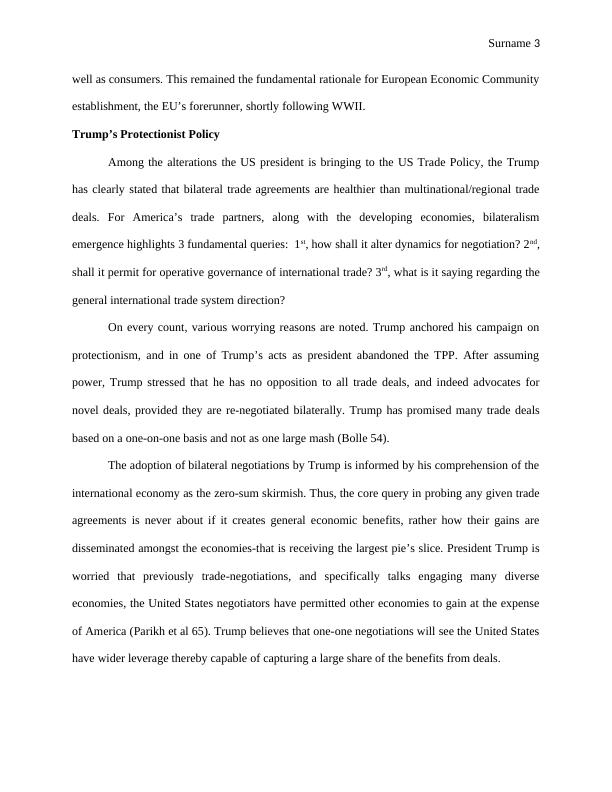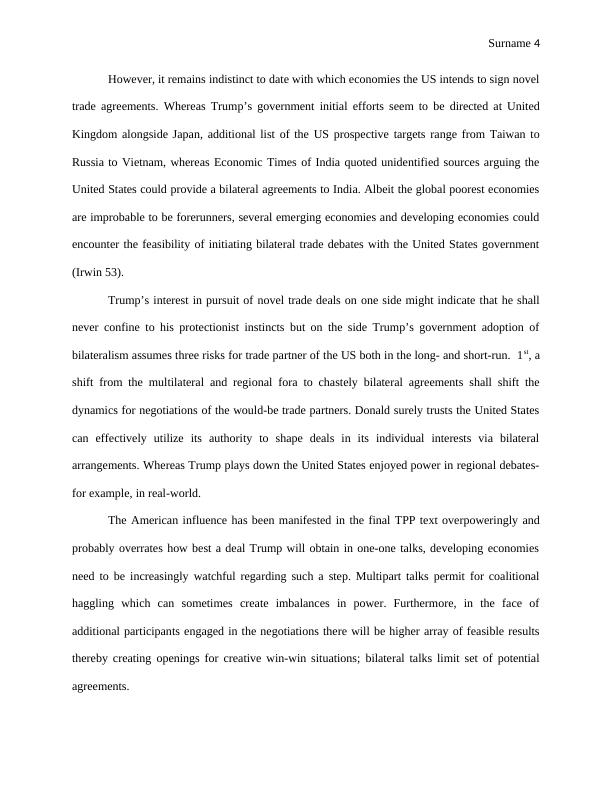Protectionism and Free Trade Assignment
14 Pages3993 Words56 Views
Added on 2020-04-21
Protectionism and Free Trade Assignment
Added on 2020-04-21
ShareRelated Documents
Surname 1Name Tutor Course Date PROTECTIONISM AND FREE TRADEIntroduction The current president of the US of North America has been cancelling bilateral andmultilateral trade agreements in favor of a protectionist trade policy. This paper seeks to explainthe consequences of this policy both in the mid- and long-run. This is achieved by analyzing bothmultilateral trade agreements and bilateral trade agreements. Definition of Protectionist Trade Policy Protectionism details the policy of protecting domestic industries from foreigncompetition via the imposition of tariffs, quotas as well as regulations on imports. Protectionismpolicy limits trade between the states, and bars foreign take-overs of local markets and firms.Protectionist policy, in economics, protectionism is such a policy that restricts trade betweenstates (countries) via such mechanisms as imposing tariffs on imports, restrictive quotas as wellas a range of additional regulations by the government. Trade Protectionism Trade protectionism defines the considered attempt to restrict imports/promote exportsvia the placement of obstacles to trade. Albeit the proponents of free-trade argument, andgrowing openness of trade, this policy remains extensively used as seen by Trump administrationthat is cancelling both bilateral and multilateral trade agreements. President Donald Trump’sprotectionist policy would hit a range of regions both in the long- and short-run where it leads to

Surname 2a severe trade conflict. On a balance, trade protectionist policy is never good for the worldeconomy, indeed not even for the United States, however, fiscal stimulus would dominate theUnited States economic growth and further might positively affect the global economy.Protectionist policy will as well lead to trade wars between the largest economy (the US) and thesecond largest economy (China) or some serious trade conflicts thereby affecting Asia, Europe,the southern hemisphere, everywhere. The theory posits that free-trade makes all things inexpensive as well as enhances qualityof goods, straight benefit each country. It builds from the idea that various economies havevarying strengths for production. Such might be an inexpensive labor force, geography,technological expertise, and a seldom/erratic resources (Gereffi 62). The arguments hold thatwhere every economy emphasized and subsequently specialized on whatever it can produce best/cheapest, it might produce healthier quality/cheaper goods. Such goods might then be tradedbetween economies thereby making each consumer excited. It is identical principle to each onespecializing in one career then trading items we need, instead of attempting to generate allproducts independently (Switzer and Daniel 56). Free-trade already lifted the entire economies from poverty. Free trade can as well bring arange of income overseas and would propel business toward ceaseless investment, solid effort aswell as invention thereby expanding their share of international market. It further relevant to thefirms which don’t undertake exportation, but currently have to keep corresponding productprices low and high quality to edge out incoming competitors. Free-trade further reinforces thelinks amongst economies, enhances co-operation on economic basis and the argument stretches,making wars increasingly less probably-anyway, it is never an astute to attack the suppliers as

Surname 3well as consumers. This remained the fundamental rationale for European Economic Communityestablishment, the EU’s forerunner, shortly following WWII. Trump’s Protectionist PolicyAmong the alterations the US president is bringing to the US Trade Policy, the Trumphas clearly stated that bilateral trade agreements are healthier than multinational/regional tradedeals. For America’s trade partners, along with the developing economies, bilateralismemergence highlights 3 fundamental queries: 1st, how shall it alter dynamics for negotiation? 2nd,shall it permit for operative governance of international trade? 3rd, what is it saying regarding thegeneral international trade system direction? On every count, various worrying reasons are noted. Trump anchored his campaign onprotectionism, and in one of Trump’s acts as president abandoned the TPP. After assumingpower, Trump stressed that he has no opposition to all trade deals, and indeed advocates fornovel deals, provided they are re-negotiated bilaterally. Trump has promised many trade dealsbased on a one-on-one basis and not as one large mash (Bolle 54). The adoption of bilateral negotiations by Trump is informed by his comprehension of theinternational economy as the zero-sum skirmish. Thus, the core query in probing any given tradeagreements is never about if it creates general economic benefits, rather how their gains aredisseminated amongst the economies-that is receiving the largest pie’s slice. President Trump isworried that previously trade-negotiations, and specifically talks engaging many diverseeconomies, the United States negotiators have permitted other economies to gain at the expenseof America (Parikh et al 65). Trump believes that one-one negotiations will see the United Stateshave wider leverage thereby capable of capturing a large share of the benefits from deals.

Surname 4However, it remains indistinct to date with which economies the US intends to sign noveltrade agreements. Whereas Trump’s government initial efforts seem to be directed at UnitedKingdom alongside Japan, additional list of the US prospective targets range from Taiwan toRussia to Vietnam, whereas Economic Times of India quoted unidentified sources arguing theUnited States could provide a bilateral agreements to India. Albeit the global poorest economiesare improbable to be forerunners, several emerging economies and developing economies couldencounter the feasibility of initiating bilateral trade debates with the United States government(Irwin 53). Trump’s interest in pursuit of novel trade deals on one side might indicate that he shallnever confine to his protectionist instincts but on the side Trump’s government adoption ofbilateralism assumes three risks for trade partner of the US both in the long- and short-run. 1st, ashift from the multilateral and regional fora to chastely bilateral agreements shall shift thedynamics for negotiations of the would-be trade partners. Donald surely trusts the United Statescan effectively utilize its authority to shape deals in its individual interests via bilateralarrangements. Whereas Trump plays down the United States enjoyed power in regional debates-for example, in real-world. The American influence has been manifested in the final TPP text overpoweringly andprobably overrates how best a deal Trump will obtain in one-one talks, developing economiesneed to be increasingly watchful regarding such a step. Multipart talks permit for coalitionalhaggling which can sometimes create imbalances in power. Furthermore, in the face ofadditional participants engaged in the negotiations there will be higher array of feasible resultsthereby creating openings for creative win-win situations; bilateral talks limit set of potentialagreements.

End of preview
Want to access all the pages? Upload your documents or become a member.
Related Documents
Protectionism & Free Trade Assignmentlg...
|15
|4017
|181
Protectionism and Free Tradelg...
|15
|4240
|50
Impact of Protectionist Policy on Macroeconomic Stability: A Case Study of United States and Australialg...
|9
|1499
|57
Impact of President Donald Trump's Protectionist Policies on US-China Trade Relationslg...
|6
|1364
|279
Trade Protectionism and Its Effects on the US Economylg...
|6
|1113
|305
The Consequences of Cancelling Bilateral Trade Agreementslg...
|14
|4248
|106
